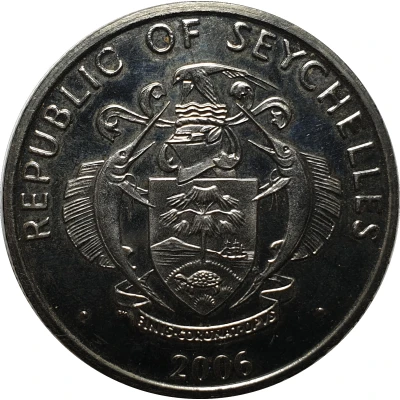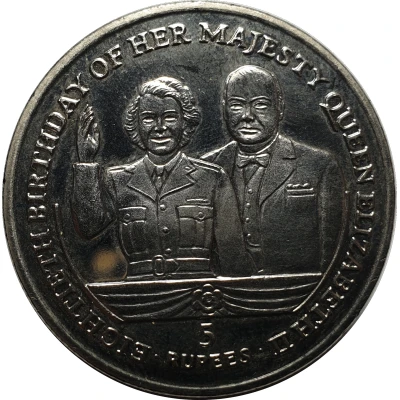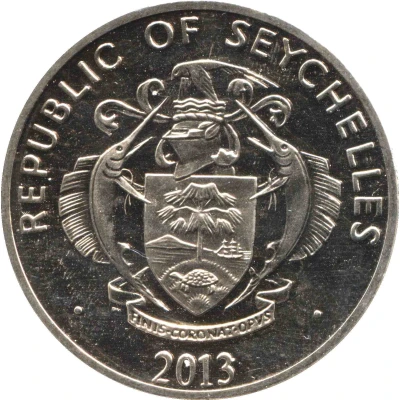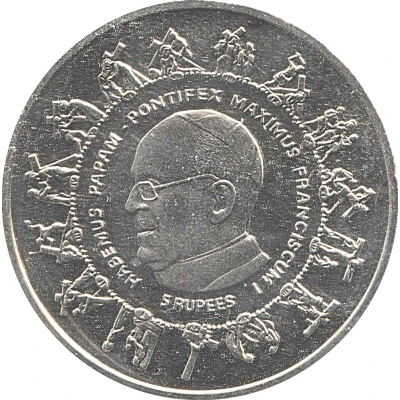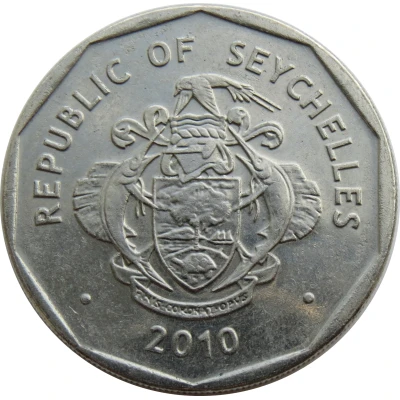
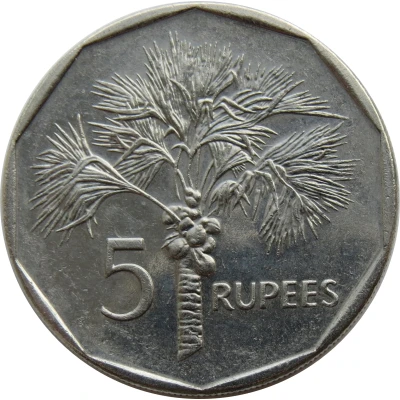

5 Rupees magnetic
2010 year| Nickel plated steel | 9.1 g | 29.0 mm |
| Issuer | Seychelles |
|---|---|
| Period | Republic (1976-date) |
| Type | Standard circulation coin |
| Year | 2010 |
| Value | 5 Rupees 5 SCR = USD 0.37 |
| Currency | Rupee (1914-date) |
| Composition | Nickel plated steel |
| Weight | 9.1 g |
| Diameter | 29.0 mm |
| Thickness | 2.03 mm |
| Shape | Round |
| Technique | Milled |
| Orientation | Medal alignment ↑↑ |
| Updated | 2024-10-07 |
| Numista | N#55292 |
|---|---|
| Rarity index | 14% |
Reverse
Palm tree (Lodoicea maldivica) and value
Script: Latin
Lettering: 5 RUPEES
Engraver: Federico Mogford
Edge
Reeded
Comment
Lodoicea, commonly known as the sea coconut, coco de mer, or double coconut, is a monotypic genus in the palm family. The sole species, Lodoicea maldivica, is endemic to the islands of Praslin and Curieuse in the Seychelles. It has the biggest seed in a plant. It formerly also was found on the small islets of St Pierre, Chauve-Souris, and Ile Ronde (Round Island), all located near Praslin, but had become extinct there for a time until recently reintroduced. The name of the genus, Lodoicea, may be derived from Lodoicus, one Latinised form of Louis (typically Ludovicus), in honour of King Louis XV of France. Other sources say that Lodoicea is from Laodice, the daughter of Priam and Hecuba.
The mature fruit of this palm is 40–50 cm in diameter and weighs 15–30 kg, and contains the largest seed in the plant kingdom. The fruit, which requires 6–7 years to mature and a further two years to germinate, is sometimes also referred to as the sea coconut, love nut, double coconut, coco fesse, or Seychelles nut. Until the true source of the nut was discovered in 1768 by Dufresne, it was believed by many to grow on a mythical tree at the bottom of the sea. European nobles in the sixteenth century would often have the shells of these nuts polished and decorated with valuable jewels as collectibles for their private galleries. The coco de mer tree is now a rare and protected species.
Interesting fact
The 5 Rupees coin from Seychelles, which was introduced in 2010, features a unique design that showcases the country's rich marine life. The coin's reverse side features an image of a sea turtle, which is a common species found in the waters surrounding Seychelles. The coin's design also includes other marine elements, such as waves and seaweed, which add to its unique and beautiful design.
Price
| Date | Mintage | VG | F | VF | XF | AU | UNC |
|---|---|---|---|---|---|---|---|
| 2010 | - | - | - | - | - | - |
Values in the table are based on evaluations by sales realized on Internet platforms. They serve as an indication only for 5 Rupees (magnetic) 2010 coin.
